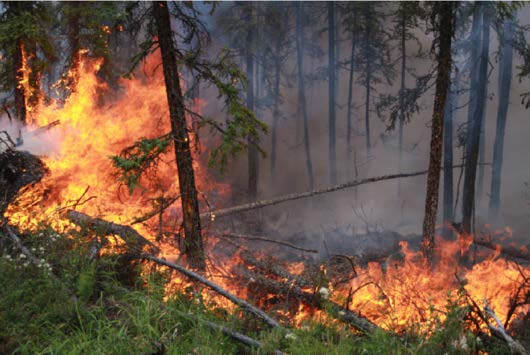Emergency Preparedness for Alaskans: Wildfires
SAL-00202 View this publication in PDF form to print or download.
By Art Nash
Although wildfires are a natural part of the boreal forest ecosystem, changes in climate — which have been especially pronounced in higher latitudes — have led to an increase in the number and severity of wildfires in Alaska over the past 50 years. According to the Alaska Center for Climate Assessment and Preparedness (ACCAP), from 2010-2020, over 2.5 times more acres burned than during the previous two decades. In addition, two of the three largest wildfires on record in Alaska occurred in 2004 and 2005.
Many factors are contributing to the increase in wildfires in Alaska. For example, warmer temperatures have led to longer snow-free periods; changes in vegetation patterns have altered the way fires progress; and insect infestations have devastated large parts of the forest, creating dead stands of highly combustible fuel. Alaska’s boreal forest and other ecosystems are certain to experience more changes in the years to come, changes that will affect the types and frequencies of wildfires, so it is imperative that Alaskans learn about the impacts these changes will bring and how to prepare for them.

Wildfires can happen anywhere in the state, although most wildfires in Alaska occur in the boreal forest, an area bounded by the Alaska Range on the south and the Brooks Range on the north. In this dry, arctic desert clime, hundreds of lightning strikes a day can touch off multiple fires throughout the boreal forest, which is made up mainly of black and white spruce along with deciduous trees, such as aspen and birch, and shrubs, such as willow and alder. Although fires also occur in tundra ecosystems, they are generally smaller and less frequent.
Government agencies and scientists are working to understand wildfires and predict when they might occur, but when it comes to fire, nothing is certain. To protect your home, family and community, the best thing to do is be prepared.
Start by creating a defensible space around your home. Defensible space is the area needed to stop or slow the spread of wildfire around your home. This zone should extend at least 30 feet from the house in all directions. Within this area:
- Thin trees and brush and dispose of debris.
- Remove dead limbs, leaves and other litter.
- Mow dry grasses and weeds.
- Maintain an irrigated green belt.
- Leave adequate space between groups of shrubs and the branches of trees.
- Prune tree branches to at least 10 feet above ground.
- Stack firewood away from home, at least 30 feet.
- Locate fuel storage tanks at least 30 feet from the home and at least 15 feet from any hanging limbs.
- Keep roofs and gutters clean.
- Reduce the density of the surrounding forest.
Look at your house. What else can you do to protect it?
- If you are building or remodeling, think about fire protection. Use fire-resistant or noncombustible materials on the roof, and/or treat combustible materials, such as decks, siding and trim, with fire-retardant chemicals.
- Design your yard with fire protection in mind and plant fire-resistant trees and shrubs.
- Keep a rake, ax, handsaw or chainsaw, bucket, shovel and ladder handy.
- Maintain an outside water source. If you don’t have a well, a water storage container with a pump and a hose could save your home.
- If you do have a well, be sure to have properly installed auxiliary wiring running from the switch box with a proper plug that can fit a 220v outlet on a portable generator (which should be able to handle the proper wattage for the generator.)
- Have a garden hose with a "Y" junction and multiple pieces long enough to reach any part of the house or other structures.
- Make sure that you have a proper fitting sprinkler distribution apparatus which will attach securely to the "Y' junction and multiple hose ends.
- No matter how well prepared you are, wildfires can still overwhelm an area, so be sure you have a plan to evacuate when necessary.
- Post emergency phone numbers in a common area of the house.
- Clearly identify your home and make sure there is good access.
- Have an evacuation plan with several escape routes and practice it with your family.
- Put together an emergency kit with supplies (food, water, first aid, clothing, radio, valuables, important documents, etc.) in case you have to evacuate.
There are many good resources available to help you prepare for a wildfire. The Alaska Department of Natural Resources Division of Forestry has a comprehensive booklet, Firewise Alaska, that tells how to maintain defensible space, modify your home for fire protection, landscape for fire protection and provide an effective water supply, and what to do when faced with a wildfire.
Sources
Alaska Division of Forestry: forestry.alaska.gov
FEMA: https://www.fema.gov/disaster/wildfire-actions
Wildfires: ready.gov/wildfires
Firewise Alaska: https://forestry.alaska.gov/Assets/pdfs/home/firewise09.pdf
Art Nash, Extension Energy Specialist and Martha Springer, Extension Communications Specialist
Revised June 2024
